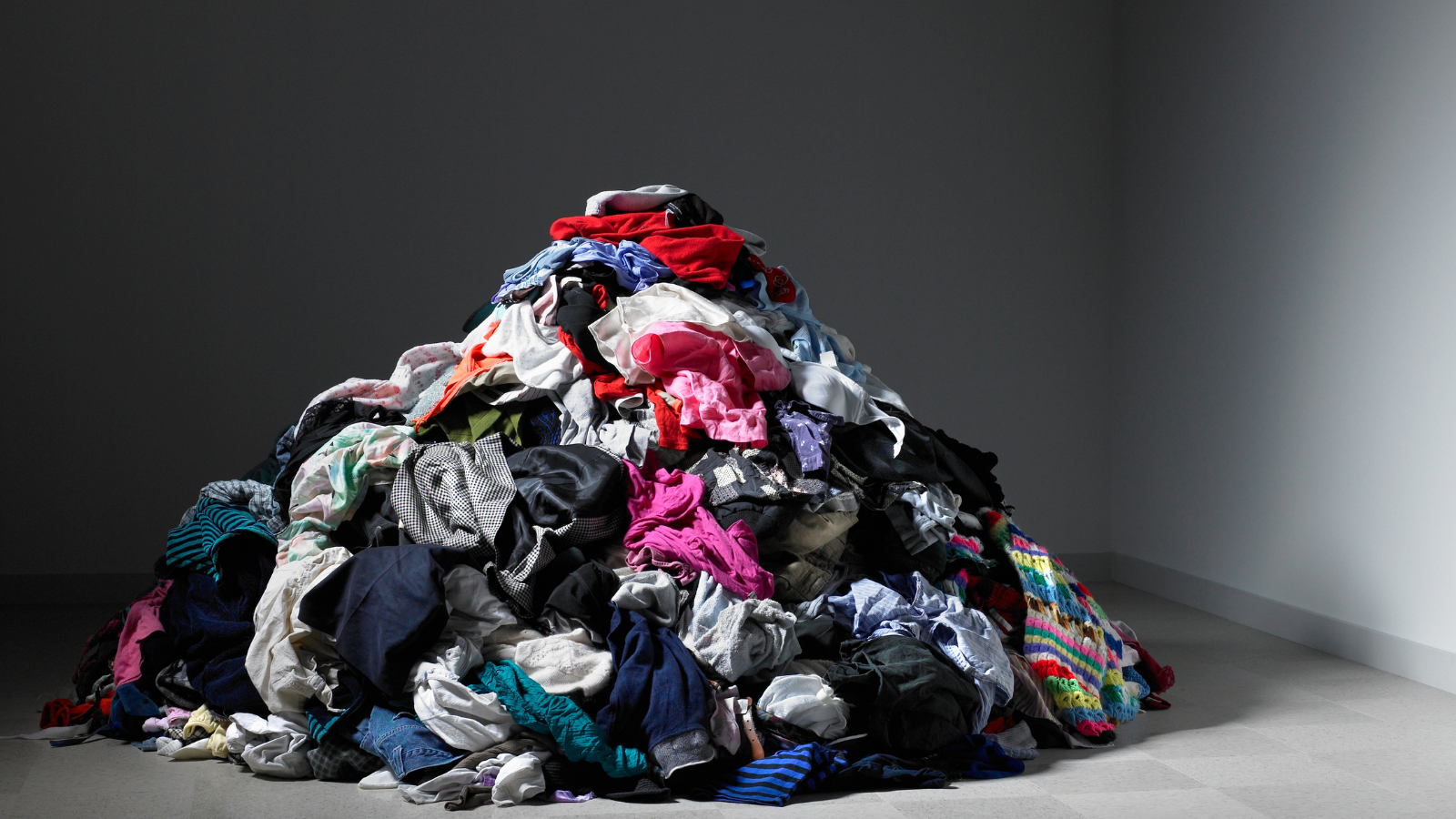Fashion industry experts answer your questions
How to avoid textile “wish-cycling” and why clothing companies need to bear responsibility for the waste crisis their products create.

During a recent webinar hosted by U.S. PIRG Education Fund as part of its Waste is Out of Fashion campaign, I had the opportunity to sit down with three expert panelists: journalist and Senior Contributor at Forbes Brooke Roberts-Islam; Founder and CEO of FABSCRAP Jessica Schreiber; and author and journalist Elizabeth L. Cline.
This is the fourth of a four part series looking at some of the highlights and lessons learned from questions our audience asked the panelists. You can read the first three installments containing interview highlights from Brooke, Jessica and Elizabeth, or view the full recording to hear the whole conversation.
This conversation has been edited for length and clarity.
Q: How does the average person, at least in NYC, deal with clothing or fabric that is not appropriate for donation?
Jessica Schreiber: That’s a good question. I first will start with what’s not appropriate for donation. In working with the city’s program and a lot of local nonprofits and for-profit reuse organizations, I think it helps everybody to understand that all textiles are still sorted by hand. There is somebody who will open up the bag, look at every single piece and decide where it goes next. And in that case, “inappropriate for donation” items would be used socks, used underwear and, in NYC, most nonprofits say used bedding.
What’s unfortunate is that because for so long textile waste has been handled by nonprofits, there isn’t really a better option or recycling infrastructure to handle that material in any other way. In the best case scenario, it would end up at a shredder like what FABSCRAP uses, where it can become carpet padding, insulation, or mattress stuffing; however, those same sanitary concerns exist in what you would be putting into your wall, carpet or mattress, so that is something where maybe fiber-to-fiber technology would do a better job. But, we just lack the infrastructure for if it can’t be donated, where does it go. So unfortunately, right now, the answer is usually landfill.
Q: What are some of the most effective or cutting edge fiber-to-fiber recycling technologies? I know that one of the issues right now with textile recycling is that if synthetic fibers are mixed in with organic fibers, we don’t always have the ability to process that. How does that play into the emerging technologies and the ability to recycle polyester (or other plastic-based synthetic fibers) if it’s mixed in with cotton or other natural fibers?
Brooke Roberts-Islam: Polyester is not so much of a problem; it’s elastane that’s a significant problem. We have denim, for example, where most of the denim that we wear has 1 or 2 percent elastane for comfort, fit and stretch. Most people wouldn’t even know that it’s in there, and that’s something that Infinited Fiber can handle quite well. By and large, denim does not tend to include large synthetic components, so that works. It’s just when you have this athleisure wear that is predominantly synthetic and doesn’t contain a significant portion of natural fibers, that you run into issues.
Polyester can be recycled, but only at a downgraded quality. So circular polyester is not a viable solution. Even if it is put back into recycling, which it can be, it’s downgraded. So what we are looking for in recycling optimally is that maintenance of the chemical structure. That the quality is as it was with virgin, which is what Infinited Fiber and Renewcell do well.
Q: Here is a related question about recycling directed towards Elizabeth. How do we avoid setting up textile “wish cycling” in the same way that we have historically positioned plastic recycling?
Elizabeth L. Cline: In my advocacy, I will sometimes say, “call your local charity,” or wherever you take your clothes. There is a chance that they have a solution for your worn out clothes. It could be that what you are donating is going to end up with a recycler, a shredder. But, then there’s a really good chance that it’s just going to end up in the landfill. It could even go all the way to the other side of the world, and then just end up in a landfill in Ghana or Kenya.
One of the things that I have tried to talk to people about is how important clothing maintenance is to the second-hand quality of clothing in the secondhand market. Some of that is difficult if you are talking about socks, underwear or bras, but it’s really important to donate clothes in good condition: sew your buttons back on, make sure you don’t just leave a stain on something and donate it.
Because that can make the difference between something having a second life, and someone hand sorting a pile of clothes and seeing a stain or a button missing and just throwing it away. Just making that little bit of extra effort can go a long way.
Q: That’s a really good tip. So if consumers do have a stained garment, is there a good place to donate that, or is it pretty much guaranteed to end up trashed right now?
Elizabeth L. Cline: There is a gray area. I have been to the big second-hand market in Nairobi Kenya and seen second-hand sorters going through clothes. Maybe if a T-shirt is exceptionally interesting but has a stain on it, someone will buy it. But maybe if it has a stain on it, that can be the thing that gets it thrown away. So that’s why it’s important to take responsibility and make the effort to try and remove it if you can.
Jessica Schreiber: I’ll just add two things on recycling as consumers. The first thing is that, whether we are talking about textiles, plastic bottles or even paper and aluminum, recycling is more of a bandaid than anything. It shouldn’t be your get out of jail free card. It shouldn’t be, “I can use this water bottle because I am going to recycle this water bottle.” Really, we have to move more towards addressing our consumption patterns and reducing or paying more attention to what we are buying. Recycling shouldn’t be the goal; that’s the last case in the hierarchy of end of life. It doesn’t change how you consume if you’re always thinking that’s an out.
The other piece is, while we have responsibilities as consumers to think about where something will go when we’re done with it, I really want to hold brands accountable, in that so much about a product’s end of life is actually a design decision.
Thinking through your footwear. Shoes are notoriously hard to recycle because everything is glued or stitched together. It’s a whole mix of materials that are really hard to deconstruct. So, at the end of life, there’s nothing that can be done with them except donate or landfill. That’s because they were designed without thinking about end of life. In what we are purchasing to wear, if we’re thinking of going natural because we know there are end-of-life options for natural fibers, if there is a brand that you like and they are only offering high-blend and lots of synthetics, they are not thinking about end of life either.
Our options as consumers are dictated by design, and we often don’t have a say in that process. That’s where policy can play a part–in having designers, brands and manufacturers think about and be more responsible for past point of sale, because that is not a place where consumers have a lot of input but have to bear the decisions and, a lot of times, the burden of figuring out that waste piece. It can be really costly–it costs a lot in New York City to take textiles to landfill. I also would like to encourage people to question brands on, “is this deconstructable? Is this recyclable?” because brands should be thinking about that as part of the design process as well.
Q: What designers if any are actively engaging in sourcing and design toward a goal of end of life garment reuse and reclamation?
Brooke Roberts-Islam: A part of the problem we have in this entire subject is the definition of what’s sustainable, what’s regenerative, all of these terms. We want straight forward answers–which brands are sustainable and which aren’t–it’s not a straightforward answer at all.
In my work, I try to look at systems. I try to look at how one part of the supply chain interacts with another and understand the macro movement and the macro consequences of the decisions made across that supply chain. It’s my belief that that’s the only way to understand where the problems lie in a system and begin to address them.
I think part of the problem we’ve had in sustainability for many years is tackling sustainability piecemeal. So, what’s the point of sourcing organic cotton if you are then going to produce 200,000 units, sell 50,000 and landfill 150,000? Or if you are going to demand that your factory produce units for a non-buyable unit price that can’t pay workers? This is a very complicated issue that needs to be dealt with in a holistic manner.
Elizabeth L. Cline: I completely agree with what Brooke is saying. I will give a couple of concrete examples of brand efforts around circularity, just so we can start to talk about what the industry is saying circularity is going to look like. From there, we can debate whether we consider those greenwashing or whether they are actually moving the industry in the right direction.
Jessica was just talking about putting the onus on brands in the design process, and the Ellen MacArthur Foundation’s Jeans Redesign project is guiding brands towards creating denim that’s made to be remade. It can be minimizing the number of rivets used in the denim or changing the composition of the fabric to make sure that it’s compatible with recycling. A lot of big companies have signed-up for that initiative–a few are Gap, H&M, Best Seller, Banana Republic, C&A and then more sustainable brands like Boyish. That’s an example of a conversation that is happening on how to make denim easier to repurpose and recycle.
Some of you might be aware, but there was some controversy a couple of months ago when ASOS designed their Circular Collection. One because I think it was maybe 8 pieces, or 20 pieces, when in a year they make 8,000 or 80,000 different styles or whatever it is. But it was interesting because it showed what corporate fashion was starting to think about in terms of designing for circularity. Some of the pieces were just made to be worn in different ways; maybe they were reversible, some of the pieces were unisex, some of the pieces were designed to be recycled and some of them were made out of recycled content. The collection showed the spectrum of what the industry might be doing in the coming years around circularity.
Q: Is there a clear answer on what is better: shopping secondhand or buying new from sustainable brands? Are there any good resources for consumers who are trying to be more conscious?
Elizabeth L. Cline: I don’t know if anyone has the right answer to that. From a sustainability standpoint, if you are reusing resources via the secondhand market, that’s a good thing. But supporting ethical and sustainable brands also has a social benefit. I think it’s a personal preference.
One of the reasons I often advocate for secondhand is because it’s affordable and accessible to everyone. It doesn’t require someone to pay a premium for something sustainable, like an expensive organic cotton dress for example.
In terms of resources, there are a lot of different guides now that help consumers navigate sustainable and ethical shopping, like the good on you app. Remake puts out a transparency report, Fashion Revolution has a transparency index. Those are some of the resources that the community tends to turn to when they are trying to shift their shopping habits.
Brooke Roberts-Islam: One thing I would like to add on is that if you are thinking about sustainability and being as sustainable as possible in every way you know how, the way to look at that is: “What choice can I make that’s going to have the least impact on the environment, that will induce the lowest carbon emissions and result in the least waste?”
I think faced with those two options, given that the large majority of the impact of the garment is in the raw materials phase–the dying, cultivation, weaving, etc–if you can buy secondhand clothes instead of new, from a lifecycle analysis and brass tax impact point of view, I think secondhand is the winner there. Not to dissuade people from buying from emerging brands because there are some great ones, but if you are looking at pure impact, I think that’s your answer.
Jessica Schreiber: I agree with the pure impact outlook and that secondhand has probably the least amount of damage to the environment involved. But, one thing that we have come across is fiber-to-fiber recyclers will purchase feedstock from FABSCRAP, but only if there is a brand that will purchase the recycled fiber and intends to make something with it.
So, more demand for recycled fibers and for sustainable goods helps that infrastructure develop more quickly and drives investment to those things. It eventually helps to bring the cost down as we saw with organic food, which used to be super expensive and now most grocery stores have at least a small organic section. If price is not an issue, that investment does go a long way in showing interest and helping to make what is now inaccessible a little more accessible overtime.
Urge your governor to act now on the growing problem of fashion waste.
It's time for clothing companies to stop throwing away brand new clothing and fueling a mounting waste crisis just because it's convenient for their business model and bottom line.

Authors
Olivia Sullivan
Find Out More

A look back at what our unique network accomplished in 2023

PIRG’s warmest wishes for a safe and happy new year

More joy, less waste this holiday season

